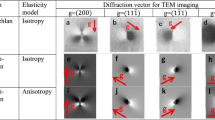Abstract
In x-ray topography studies, ray tracing simulation has been particularly useful in identifying and characterizing Burgers vectors of dislocations using only one reflection instead of the traditional method of recording at least three reflections and applying \(\vec{g} \cdot \vec{b} = 0\) and \(\vec{g} \cdot \vec{b} \times \vec{l} = 0\) criteria. In this study, ray tracing simulation of expected dislocations in (AlxGa(1–x))0.5In0.5P epitaxial layers on GaAs substrates has been carried out by using well-known expressions for displacement fields around dislocations. By comparing the simulated images with observed images on monochromatic x-ray topographs, the Burgers vectors have been characterized. The x-ray topographs from the (AlxGa(1–x))0.5In0.5P epitaxial layers also reveal a unique pattern consisting of a series of circular dark contrast features from inclusions. These dark circles decrease in size as the center of the inclusions is approached. Ray tracing simulated image of an inclusion assuming a spherical strain field matches well with the experimental image, thus providing information on the level of strain around the inclusion.
Similar content being viewed by others
References
Th Gessmann and E.F. Schubert, J. Appl. Phys. 95, 5 (2004).
C.H. Chen, S.A. Stockman, M.J. Peanasky, and C.P. Kuo, Semiconduct. Semimet. 48, 97 (1997).
M. Dudley, X.R. Huang, and W. Vetter, J. Phys. D Appl. Phys. 36, A30 (2003).
R. Dalmau, H.S. Craft, J. Britt, E. Paisley, B. Moody, J.Q. Guo, Y. Ji, B. Raghothamachar, M. Dudley, and R. Schlesser, Mater. Sci. Forum 924, 923 (2018).
T. Zhou, B. Raghothamachar, F. Wu, R. Dalmau, B. Moody, S. Craft, R. Schlesser, M. Dudley, and Z. Sitar, J. Electron. Mater. 43, 838 (2014).
J.Q. Guo, Y. Yang, F.Z. Wu, J. Sumakeris, R.T. Leonard, O. Goue, B. Raghothamachar, and M. Dudley, Mater. Sci. Forum 858, 15 (2016).
X.R. Huang, M. Dudley, W.M. Vetter, W. Huang, W. Sia, and C.H. Carter Jr, J. Appl. Cryst. 32, 516 (1999).
N.F. Mott and F.R.N. Nabarro, Proc. Phys. Soc. 52, 86 (1940).
J.P. Hirth and J. Lothe, Theory of Dislocations, 2nd ed. (Florida: Krieger Publishing Company, 1982), pp. 59–86.
N. Miyazaki, A. Kumamoto, and C. Harada, J. Cryst. Growth 271, 358 (2004).
J.W. Matthew, S. Mader, and T.B. Light, J. Appl. Phys. 41, 9 (1970).
A. Authier, Dynamical theory of x-ray diffraction (Oxford: Oxford Science Publications, 2003), pp. 355–403.
B.W. Batterman and H. Cole, Rev. Mod. Phys. 36, 3 (1964).
A.O. Okunev and G.A. Verozubova, J. Appl. Cryst. 48, 1228 (2015).
A.O. Okunev, G.A. Verozubova, E.M. Trukhanov, I.V. Dzjuba, P.R.J. Galtierd, and S.A. SaidHassani, J. Appl. Cryst. 42, 994 (2009).
Acknowledgments
Work supported by Lumileds and this research used resources of the Advanced Photon Source (Beamline 1-BM), a U.S. DOE Office of Science User Facility operated for the DOE Office of Science by Argonne National Laboratory under Contract No. DE-AC02-06CH11357. The Joint Photon Sciences Institute at SBU provided partial support for travel and subsistence at the Advanced Photon Source.
Author information
Authors and Affiliations
Corresponding author
Additional information
Publisher's Note
Springer Nature remains neutral with regard to jurisdictional claims in published maps and institutional affiliations.
Rights and permissions
About this article
Cite this article
Peng, H., Ailihumaer, T., Raghothamachar, B. et al. Ray Tracing Simulation of Images of Dislocations and Inclusions on X-Ray Topographs of GaAs Epitaxial Wafers. J. Electron. Mater. 49, 3472–3480 (2020). https://doi.org/10.1007/s11664-020-07981-7
Received:
Accepted:
Published:
Issue Date:
DOI: https://doi.org/10.1007/s11664-020-07981-7



